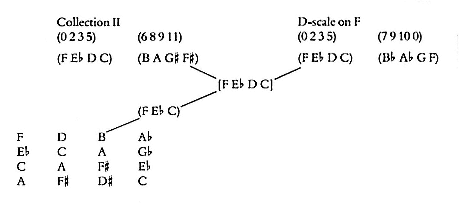The Diatonic Component
As can readily be seen in Example 65, the transposition to (D C B A) in the final climactic block of the "Augurs" movement is foreshadowed by the C-
[21] The first of these sketches on page 5 of the sketchbook, Example 67a, is crossed out.
A-D-A phrase of the opening bassoon melody and by the (D C B A) fragment at no. 6+4. Of concern at no. 37 in the "Ritual of Abduction," however, is the abrupt return to Collection III's (E


















Still, patches of unimpaired diatonicism occasionally arise. The D-scale (or Dorian) fragment introduced at no. 37 returns in transposed form at no. 46. And in moving from the octatonic block at no. 44 to the unimpaired D-scale on F at no. 46, the connecting link or pivot, that which is in turn shared by these two blocks of distinct referential character, is the (0 2 3 5) tetrachord.
Thus the presiding (F E






Indeed, similar equations pertain to those blocks and passages of Part I where the octatonic and diatonic collections may be said to interpenetrate . At no. 10 in the Introduction two diatonic fragments in the clarinet piccolo and oboe are superimposed over Collection I's B













[22] The dotted lines in the analytical portions of Example 65 signify octatonic-diatonic interpenetration, with the octatonic component on the left side, the diatonic on the right. At the collectional level, brackets mark off the (0 2 3 5) units held in common.

Chart 6:
"Ritual of Abduction," nos. 44–47
In sum, the two adjoining (0 2 3 5) tetrachords of the octatonic scale are (0, 6) tritone-related while those of the diatonic D-scale are (0, 7) fifth-related. (The octatonic scale contains four overlapping (0 2 3 5) tetrachords, which, in passages of octatonic-diatonic interaction, could imply eight possible D-scales. Here we consider only the two adjoining ones.) And as shown in Chart 6, the critical point of distinction is likely to arise at the pitch-number 6/7 juncture of the two tetrachords. In moving from an octatonic to a diatonic or octatonic-diatonic framework, pitch number 7, replacing number 6, does in fact often intrude to signal this shift. At no. 25 in the "Augurs of Spring," only F of the (C B











Hence, as a subset of both the octatonic and diatonic collections, the (0 2 3 5) tetrachord serves as the principal connecting link between blocks of octatonic, diatonic, and octatonic-diatonic content. And when (0 2 (3) 5) is incomplete, it may in addition connect an (0 2 3 5) partitioning of the octatonic collection with a dominant-seventh partitioning, closed-position, first inversion. Hence, too, as a surface-articulative unit, it embodies matters of deep structural concern to the harmonic, contrapuntal, and referential character of The Rite .